The more I examine the universe and the details of its architecture, the more evidence I find that the universe in some sense must have known we were coming.
-Freeman Dyson
When we look out at our Universe today, we see all sorts of beautiful things throughout space, from galaxies and clusters, distributed roughly evenly throughout space:
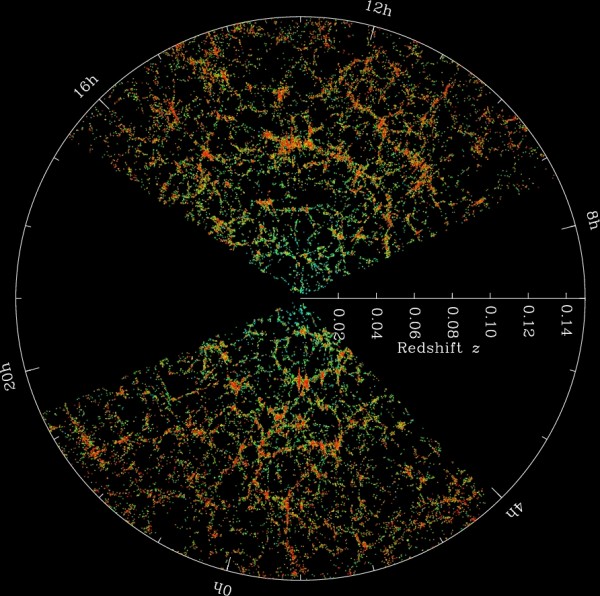
to the cosmic microwave background (also known as the last scattering surface), radiating at the same temperature in all directions.
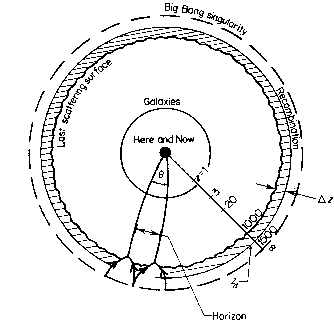
We also see, when we try to measure the shape of the Universe, that there are three major possibilities: it could be flat like a plane, curved positively like a sphere, or curved negatively like a saddle.

We learn two important things from making our measurements:
1.) The Universe has, on average, the exact same properties in all directions in space. Same average density, same average temperature, same average galaxy count, etc., despite the fact that these regions are separated by billions upon billions of light years.
2.) The Universe, on the largest scales, appears to be completely spatially flat, without a hint of overall curvature in either the positive or negative directions.
We are curious creatures, and are bound to ask the question of why? Why is the Universe the same in all directions, when there's no reason for it to have not started with different properties in different places? Why is the Universe spatially flat, when even a slight change in the overall matter density or expansion rate would have given us a curved Universe? Physicists call these problems the horizon problem and the flatness problem, and they are two major observations that the Big Bang cannot explain.
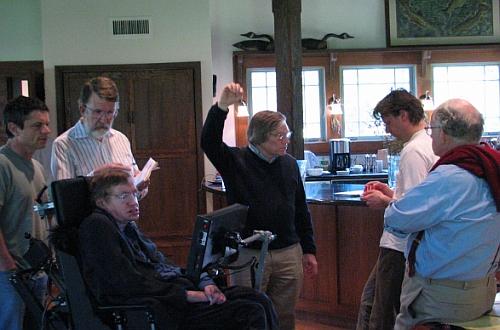
In 1979, a young theoretical physicist named Alan Guth (center, above) came up with a theory that could explain both of these problems, by stating what happened before the big bang! His big idea was the theory of inflation, which says the following. Imagine a Universe with different conditions everywhere. Some regions might be expanding, some might be contracting, and some might be stationary. Some might have positive curvature, some might have negative curvature, and some might be flat. Some might have a lot of matter, some might have little to none. Some could be very, very hot, and some could be practically at absolute zero.
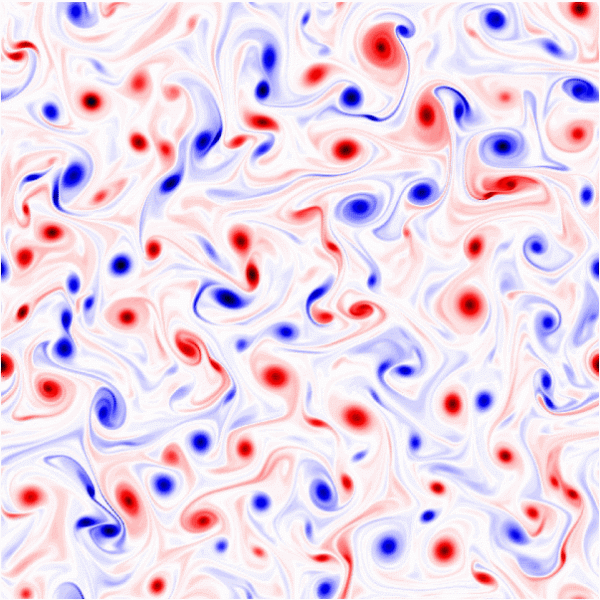
In other words, it doesn't matter what your initial conditions are to the Universe. What matters is that, at one point in space, in one of these regions, the right conditions to have inflation exist. Inflation takes this one region of space and expands it exponentially.

In just a tiny fraction of a second, inflation can take a region the size of a proton and stretch it to be billions of times the size of the visible Universe. This has three very important effects.
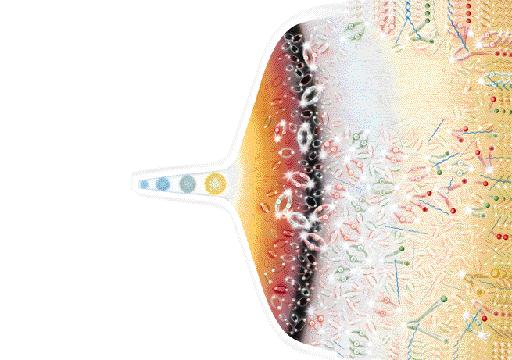
First off, the horizon problem is solved. If you take a very small region with the same temperature, density, and expansion rate within that region and expand it to be as big as the Universe, then all of a sudden everywhere within your Universe should have the same temperature, density, and expansion rate. Problem #1 is solved.
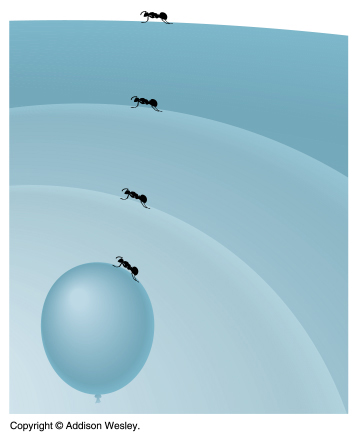
Second, it doesn't matter what the shape of your Universe was before inflation. Inflation comes along and makes it so big that -- with our instruments only able to measure what's within our visible Universe -- our Universe appears to be flat.

This is in the same sense that, if all you could see of Earth was what was within 100 feet of you, you couldn't tell that it was curved like a sphere; it would look flat to you. The Universe looks flat to us in exactly the same sense.
But the last (important) thing that inflation predicts was so profound, because it wasn't yet observed when it was predicted. Quantum mechanics tells us that empty space isn't completely empty. It's full of particles (matter) and anti-particles (antimatter) that continuously get created, live for a brief while, meet back up together, and annihilate one another again. This happens over very short timescales, and gives rise to the Casimir effect.

When inflation occurs, these particle/antiparticle pairs are suddenly ripped apart across the Universe by the exponential expansion. Instead of space being truly uniform everywhere, there are slight fluctuations -- overdensities in some regions and underdensities in others -- that arise from these quantum effects in the inflating Universe. Inflation predicted what these fluctuations would look like in the 1980s, and these fluctuations were finally observed to the desired precision in 2003, with WMAP's measurement of the fluctuations in the cosmic microwave background.
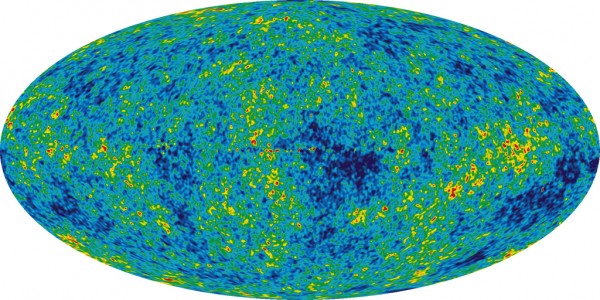
And all of this happened before the big bang ever took place. Was it for the first 10-35 seconds of the Universe? Possibly, but it's also possible that the Universe existed for billions of years before inflation, or not at all. It's also conceivable that time didn't have the same meaning that it does now back then. Regardless of what happened, inflation prevents us from knowing right now; it wiped out any information about the Universe that existed before inflation!
So that's our starting point in the greatest story ever told. Inflation is the first thing we can really knowledgeably speak about, and it sets up all the conditions we need -- including a flat, uniform Universe with the right fluctuations -- to start our Universe off with a bang!
- Log in to post comments

The 5th picture, the white-red-blue one that looks like turbulences, what does it show?
So what conditions in space might give rise to inflation? I read a post on your old blog about a hypothetical 'inflaton', but that has been a while.
Also is it correct to say that based on what we know, the Big Bang did not necessarily involve a singularity?
Sorry for the amount of questions but I suppose you will get a lot more since this subject confuses alot of people ;)
When you say "the universe is flat" I think of a piece of paper. But I know that analogy is flawed, unless the piece of paper is _very_ thick, and large. I just don't get how you can call it flat. Can't we look 360º from our little rock and, with tools like Hubble, see thousands of light years in each direction?? That just don't seem flat to this simple Kansas farm boy...... Help me Professor, this makes my brain hurt!
I've seen this before, but I've never seen anyone assert that inflation takes place before the big bang. Everything I've read has indicated that the BB is the primordial singularity that differential geometry on (3+1)-manifold spacetimes assures us must exist. Inflation, if it occurs, is something that happens within spacetime, and so it doesn't happen "before" the BB.
I suppose it's possible that you mean something very different than I do when you say "big bang". If so, what exactly do you mean? And if not, how do you back up saying that inflation takes place before the initial singularity of spacetime?
@dave: have you heard the old riddle about the bear hunter who walks 10 miles south from his camp, then 10 miles east, and then 10 miles north and ends up back at his camp? Somehow he's made a triangle with two right angles in it! And that can only happen because the surface of the earth is curved.
It gets a little more complicated than that in cosmology, but that's the basic idea of what people mean by "flat". It's not "thin" like a two-dimensional sheet of paper. It means that all triangles you draw in space will have angles that add up to 180 degrees, and other similar effects.
@dave w.: Remember that space isn't actually perfectly flat -- it's actually quite bumpy and lumpy, since mass causes space to curve. Just like the Earth's surface is bumpy and lumpy on the local scale, but on a larger scale it's actually pretty smooth, and has an overall positive curvature. Just so the space of our universe is bumpy and lumpy, but on a large scale has an overall zero curvature.
Fascinating stuff. However ...
Can you give a bit of context for this quote? Frankly, as it stands, it sounds to me about as arrogant and silly a position as a human being could hold.
There must be something more here ...
Second that. I am puzzled.
The riddle of the hunter doesn't quite apply, since when the hunter is walking east he's not walking in a "straight line" (great circle) but instead is following a parallel of latitude. So his route is not a triangle.
However, if you imagine him walking from the north pole to the equator, turning left exactly 90 degrees, walking a quarter of the way around the equator, turning left 90 degrees again, and walking back to the north pole, you have a triangle where all three angles are 90 degrees.
(To generalize, if I recall correctly the sum of the interior angles of a triangle differs from pi radians by an amount equal to the integral of the curvature over the area of the triangle. So for a space of constant positive curvature, such as a sphere, the sum of the angles goes up with the area of the triangle; for a space of constant negative curvature, the sum of the angles gets smaller as the area increases.)
@Andrew: yes, I simplified a bit to be suggestive, and to relate to a riddle someone may have already been familiar with (including the seemingly impossible catch at its core). If you want to have straight lines, you can make the path extend from the north pole to the equator and so on, but then no hunter could actually walk it in a day.
The more accurate generalization, by the way, discusses the rotation of angles as we move around closed loops. Specifically, the curvature at a given point is the limit of the ratio of the rotation to the enclosed area as we pass to smaller and smaller loops based at that point. For constant curvature it's easy to invert this relationship and integrate to find a total angular discrepancy proportional to the area enclosed, whether the path is a triangle or not.
As I understood it, inflation is the BB, what this means is that what we call Universe, is actually a special state of a very small region of a previous (thus 'before' the BB) "Totiverse".
er...
right? :/
As I understand it, the universe is "flat" in the sense that you can't get a wormhole beween two points. If you bend a piece of paper into a tube, you can then poke a needle through and then come out in an entirely place in the paper without having actually travelled very far. If the universe is bent similarity, you can "poke" it with some very massive objects and get through to the other side.
But it's not.
If the BB is what created our Universe, i,e. from an infinitessimally small singularity comes all, including spacetime itself, out of nothing, then it stands to reason there couldn't have been anything to inflate prior to the BB.
@Joel: No. A piece of paper rolled up into a cylinder is "flat" in this geometric sense, but not in the sense you propose.
Hmmmmm, yes, that's probably true. What, then, would be the curved topology equivalent of some flat-topology paper?
@Joel: I'm really not sure what you're looking for (setting aside the pedantic point that curvature is geometric information, not topological).
If this was true, wouldn't you expect an equal amount of matter and antimatter in the universe? Or are the dense antimatter regions so far away from us that we can't detect them.
@Bee #1:
It's cosmological sperm. (I'll be here all week, folks. Tip your servers!)
Actually, I believe it depicts the pre-inflation universe, with drastic variations in properties from point to point. From the preceding paragraph: Imagine a Universe with different conditions everywhere.
Actually, I don't think it was a particularly pedantic point, so much as an indication of my obvious confusion about the subject :p
Oh well, it's another area I really ought to getting around to hitting the books on.
Is simply to learn, and thanks to share!
I've always (well, you know what I mean) looked at the universe as having to have expanded into something that was already there, not a total "void". I had gotten the impression that the void concept was only a simplification of the "fact" that once the universe had begun expansion, it began overriding what was already there, thus what was there may as well have been not there. Obviously what was there was of SOME import, but the "void" impression worked as a first-pass idea.
As a slightly more fanciful take, I've also often imagined that the expanding universe was expanding into/over spacetime that would be indistinguishable from what we would call it today, i.e. that some kind of universe was already there and was being "overwritten" by this new expanding wavefront. It's mostly pointless to really talk about such a concept as real, but it makes for good writing material...
Another thought was that whatever may have been present pre-BB were the vestiges of "failed" inflation events - that "something" almost happened but did not, but left bits of its mess floating about. To me that puts the BB on more solid philosophical footing - that, while being a truly special event, it was not the absolutely unique, one-of-a-kind, never-to-happen-again event that most picture it as.
But I will readily admit to being an amateur that just happened to be really good at math and science way back when in school. But how the smeg did I miss Guth?!
@John/Nemo: "big bang" can also be used to refer to the subsequent development of the universe (i.e. the current observed Hubble expansion). So in that sense you can think of inflation as the bang (Guth) that occured before the "big bang" expansion that we observe today.
First time commenter here.
In the beginning IF all matter and energy was presumably homogeneous,in sync,harmonious,when all forces combine,when all matter is of the same phase,no momentum, etc.same everything, would this not constitute a non-gravity situation and if you had a non-gravity situation, wouldn't the largest expansion then be possible (inflation) until the separation of forces causes relationship between matter?
Would not the total lack of gravity be the causational event of a big bang?
Even an infinitely expanding universe should have the ability to contract at the same time.
Lack of gravity=Big Bang. Your thoughts?
Oh, and by the way, great blog, love your post.
thanks this is a nice blog...i hope you continue to write and keep the blog actual..
Thirded.
And I'll second that.
Quantum mechanics tells us that empty space isn't completely empty. It's full of particles (matter) and anti-particles (antimatter) that continuously get created, live for a brief while, meet back up together, and annihilate one another again.
Here you say that matter and anti matter are continuously created, live briefly, meet BACK up together, and annihilate one another again. My question is, how do we not see the energy released from the collisions of matter and anti matter, as i was under the impression that large amounts of engery are released when these two 'annihilate' one another. Secondly you say they meet back up AGAIN, suggesting they were once in contact previously. How is this possible?
he more I examine the universe and the details of its architecture, the more evidence I find that the universe in some sense must have known we were coming.-Freeman DysonWhen we look out at our Universe today, we see all sorts of beautiful things throughout space, from galaxies and clusters, distributed roughly evenly throughout space:to the cosmic microwave background.
Thought you might be interested in this:
http://sciencenow.sciencemag.org/cgi/content/full/2010/105/2?etoc
crd2,
You mean why doesn't the energy from annihilation matter for our daily lives? The answer is that the particles are tiny. The atomic bombs, if I recall correctly, converted about 2 grams of mass into energy. An electron's mass in grams is something like .0000000000000000000000000009. So the annihilation of an electron and an anti-electron is going to mean nothing on ordinary scales.
As for your other question:
The particles were in previous contact - they were created together. Enough energy was "borrowed" from the Universe to create two particles - which is permitted under some circumstances by the Heisenberg Uncertainty principle. In keeping with conservation of electric charge and other properties, particles are created in pairs.* For instance, producing an electron alone is not allowed because it would create a net negative charge, but producing an electron and an anti-electron (which has a positive charge) is fine. The particles come into existence together. Since they have opposite electric charges, they are attracted to each other, and annihilate.
*It might not always be in pairs. I am not a particle physicist, but there might be some particle that would violate no conservation laws if it were created by itself.
Okay, you got it. Tomorrow, we'll have some Q & A: Did Inflation come before the Big Bang?
Any follow-up questions you want answered on that topic?
Nice article Ethan. You explained 'flat' and 'curved' very well and supplied a picture. To review what is above: Flat - triangle angles equal 180. positive curved - triangle angles greater than 180, negative curved - triangle angles less than 180.
As far as inflation happening before the Big Bang, many say the Big Bang is STILL happening as the universe expands space.
Is there a defined threshold of inflation, where a expansion (BB) results in the seperation of mass from its geometry?
Appreciate the explanations of "flat", thanks to all who helped me understand the concept!
Nice thoughts,twists, summary, provocative and yet so many questions.
You say:
"In just a tiny fraction of a second, inflation can take a region the size of a proton and stretch it to be billions of times the size of the visible Universe. This has three very important effects." Wow, so many extraordinary hypothesis implied in just one sentence.
So in your view Ethan, since the "big bang" starts after inflation; and since inflation can take the infinitesimal to something much bigger than the visible universe; it would seem that you've left only the smallest amount of expansion of the visible universe to be accounted for by "your version" of the hypothetical big bang. Possibly are you suggesting that the "big bang" should be renamed the "little bang"?
Thomas,
If you look up the history of the Big Bang, you'll see that this name was pinned on to it as a pejorative by people who abhorred the theory in order to ridicule it. George Gamow, a principal in developing the theory, hated the name but couldn't keep it from sticking.
what evidence leads us to believe that the universe is spaciously flat and our gallexy is just like others light years away?
The Big Bust!
Hi Ethan, nice work here, I enjoyed the reading and found you responding quite considerate. I have two thoughts I will try to explain best I can, one on the "singularity" and the other on geometry versus actuality.
In my imagining, the big bang as there is no perspective and size relativities may be a big bust, once dimensionality occurs (the singularity) it crumbles in a frenzy, going from one piece to two pieces etc. This dissolution of the point may be ongoing. Is there any reason this cannot be?
In arriving at a point, lines must be crossed. Geometrical lines are constant however "true" lines may, no, let me venture beyond my knowledge here and say must have frequency, although this frequency could be in two dimensions. When this line is crossed by another line in frequency, the third and followong dimensions erupt.
I appreciate your good work.
About nothing creating the universe...there is a great quote
"Why would anyone propose such a thing..why entertain such a notion. Its ascribing something to nothing. Its like saying--something created the universe and that something Is nothing."
Inflation predicted what these fluctuations would look like in the 1980s, and these fluctuations were finally observed to the desired precision in 2003, with WMAP's measurement of the fluctuations in the cosmic microwave background.
"This seems to be in the latter category. It's ghoulish."
There are so many beautiful, ironic juxtapositions.
At the same time, it sucks capital away from private enterprise, which is the real job creator.
This was so funny to watch. The mascot did such a great job with this. I would love to see more videos like this in the future.
Is the inflation that you are referring to being there before the "bang", the same as the expansion that we are still seeing today? If not,then are they two entirely different concepts, or are they also somehow related? By related, I mean such as in a cause and effect relationship. I am not an astrophysicist by any means, so bear with me if my questions seem elementary. I understand how the concept of inflation affects our perception and ability to measure the universe in it's entirety. I am just not entirely clear on what the inflation's role was in relation to the birth of the universe as we now know it. (that is to say, it's place in the series of events, and how it could take place before the accepted theory of the "big bang") - Ahaus Tool Engineering Inc
Interesting article .I have learned a lot from a discussion of shape of universe before inflation and after inflation.Also can you please write a full fledged article on matter and anti-matter.
Very interesting stuff. Again, I'm not a scientist, but I completely understand what you're saying here. Now, what I do not grasp is why the phenomenon of inflation is capable of such drastic and fast expansion to make all of this possible. Also, I read somewhere there was really no "before" the Big Bang, since time itself didn't exist. Could you elaborate a bit on these topics?. Thanks. Hank Reiss from repossessed cars basics.
As we know, black holes are not much in our universe. On the other side of the black hole is a black hole, also known as the universe. Our universe itself was a black hole to begin with.
My question is how can a black hole form without having the force of gravity to be formed yet? Is it due to the temperature of the universe to be so collosal, that energy can't turn into matter due to the absence of protons, neutrons, and electrons, and concetrates in one region, forming a black hole?
In my imagining, the big bang as there is no perspective and size relativities may be a big bust, once dimensionality occurs (the singularity) it crumbles in a frenzy, going from one piece to two pieces etc. This dissolution of the point may be ongoing. Is there any reason this cannot be?
The only reason Alan Guth invented inflation was to try to save the fataly flawed Big Bang in regard to the horizon problem.
Now this may seem a little odd but I would like to discus eveidence. Where is the observational (or other) evidence for inflation ? Given that inflation is supposed to have happened before the Universe bacame transparent i.e. before the last scattering surface existed, how is it proposed that inflation will be detected ?
If ''the quantum vacuum cannot be perceived or measured directly'' then how can you tell it is not empty ? As that is the definition of a vacuum. Which experiment provided evidence of paticles ''continuously get[ting] created'' ? But then, in the box, you say that these are virtual particles, but as virtual means not real, are these particles real or not ? And if these particles ''do not exist as observable entities'' the how do you know that it's their influece that is causing the Casimir effect and not something else ?
When discussing shape, you give three examples: zero, positive and negative curvature. These are all 2-dimensional surfaces and the Universe is 3-dimensional. If you take any three points, not in a strait line, they will form a flat (angles = 180 degrees) triangle. The Universe is Euclidean, it is only 2-dimensional surfaces that can be non Euclidean.
I have learned a lot from a discussion of shape of universe before inflation and after inflation.I would love to see more videos like this in the future.
I realize by your devaluation of tested and accepted science that you are mainly trolling and have no real interest in answers. But those are simple enough for the innocent bystander:
Guth was interested in BB theories because they were the best and remain so, as evidenced by how inflation fitted into it. The standard cosmology is a BB theory.
The post and the thread supplies several observations and test that you blithely ignore. It is moreover part of standard cosmology, so tested beyond reasonable doubt in conjunction with it on the cosmic microwave background. (See mezzi rifle case comment.)
Further its effects can be tested on its lonesome, starting with WMAP and continuing with Planck, but here the certainty is still somewhat shy of 3 sigma.
The post described this, the Casimir effect. The remainder of that part relates to how science test theories, is not related to cosmology specifically and is a large subject.
General relativity tells us it is not, and the post describes how it appears to us.
I was looking at bubbles forming in a glass of champagne and it struck me that this could be an analogy as to the start of our universe.
It certainly would make it easier (for me) to understand the origin of our universe. Just imagine, our universe popping into existence from a mother soup which is a lot more dense than what we have here. Positive pressure Via the big bang giving a bubble like effect which survives defines and delineates the boundaries of our universe.
A greater mass outside the boundaries of our universe would (in no particular order) go a long way to explaining phenomena such as,
The increase in the rate of expansion of the universe,
Would negate the need to have spooky dark energy to satisfy the mathematical needs of the current model.
It would explain inflation.
It could also possibly explain dark matter.
Could possibly help with black holes although that may just be a local (our universe) phenomena.
Also allow for the existence of multiple universes.
Allow prediction of a topography for our universe.
There is the obvious question as to where the mother soup came from? I can't think that far ahead.
What do you think? Help me Obi Wan Ethan
Aldo, an analogy should help illuminate something and explain it.
I don't think your idea is helping to do that, other than giving you an analogy that works as long as you don't check.
Bohr's atom helped explain the disbursement of items in an atom. Fitting a wavelength to the shell explained the reason why electrons hit in shells that could occupy more electrons.
Heck, even the plum pudding model explained what the atom could be like and gave a prediction that led to the idea that the atom wasn't like that.
For most of the things you're saying the idea helps explain, if you tried to work it out, you'd have an answer that is obviously wrong, therefore it doesn't illustrate anything in reality.
But trying to apply it with some rigour to see if it, for example, explains the increase in the rate of expansion of the universe, is a useful exercise if you're interested in physics and want to take it to university.
Anothetr cyclical model of a set of 3-volumes, hence inclusive of pre-Big Bang. see https://sites.google.com/site/zankaon